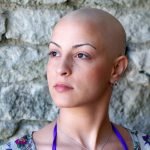For most people, a cancer diagnosis is a turning point in their lives. The thought that death could be imminent is very scary and sobering. Once the disease is considered in remission, it is cause for celebration, but life afterward is usually tempered by the desire to do everything possible to remain healthy and illness-free. Or at least, that’s the expectation most of us would have. According to new research, though, that may not be the case for a sizeable segment of melanoma survivors who seem quite willing to engage in behaviors that may risk sun damage to their skin.
The study, which was conducted at the Yale School of Medicine in New Haven, Connecticut, found that regular unprotected exposure to ultraviolet light rays was not uncommon among those who had lived through a bout with melanoma.1 Jaslow, Ryan. “”Shocking” number of melanoma survivors tan, don’t wear sunscreen: Study.” CBS News. 9 April 2013. Accessed 17 April 2013. http://www.cbsnews.com/8301-204_162-57578621/shocking-number-of-melanoma-survivors-tan-dont-wear-sunscreen-study The participants were more than 27,000 adults from across the United States who had responded to a health survey in 2010. Of this large group, the researchers isolated 171 subjects who reported an earlier diagnosis of melanoma.
In general, the melanoma survivors tended to be more careful about sun protection than the public at large. The study found that 15.6 percent of those who had suffered from melanoma sought out shady areas if they were going to be outside for longer than an hour (which means 84.4% did not) compared to 10.5 percent of the rest of the population. They were also better about covering up their skin. More than 31 percent of melanoma survivors reported wearing a baseball cap when outdoors and 20.5 percent chose hats with a wide brim, as opposed to their peers without melanoma, 18 percent of whom wore baseball caps and a mere six percent who went with wide-brimmed hats. In addition, 12 percent of melanoma survivors opted for long sleeved shirts in the sun, while only about five percent of the remainder of the subjects report wearing long sleeves.
While those numbers are far from ideal for people who have never had a diagnosis of skin cancer, they are downright disturbing for the melanoma survivors. And that part of the findings was the good news. When it comes to wearing sunscreen during time spent outdoors, more than 27 percent of the melanoma sufferers said they don’t use it. There were 15.5 percent of this group who said they rarely or never seek out the shade when they are outside for a lengthier period of time. And, perhaps worst of all, two percent of melanoma survivors admitted to going to a tanning salon.
Now, tanning salons are just a bad idea all around for everyone, cancer survivor or not. They are dangerous, and have been linked in studies to several types of skin cancer including melanoma and cancer of the eye.2 “Indoor Tanning.” Centers for Disease Control and Prevention. 21 March 2013. Accessed 19 April 2013. http://www.cdc.gov/cancer/skin/basic_info/indoor_tanning.htm And the tanning salon industry has a long history of denial of these facts. A 2012 investigation funded by the Energy and Commerce Committee of the U.S. House of Representatives found that 90 percent of the tanning salons approached with questions about safety denied that there is any link between tanning beds and cancer.3 Conley, Mikaela. “Congressional Investigation Finds Tanning Salons Lie About Health Risks to Patrons.” ABC News. 1 February 2012. Accessed 19 April 2013. http://abcnews.go.com/Health/federal-investigation-finds-indoor-tanning-salons-deny-health/story?id=15483714#.UXG-Whwbwg0
But even if we never enter a tanning salon again, our overall protection from UV light exposure needs to be better. Melanoma is likely the most hazardous type of skin cancer because if it metastasizes, it is very difficult to treat and often fatal.4 “Melanoma.” Skin Cancer Foundation. Accessed 19 April 2013. http://www.skincancer.org/skin-cancer-information/melanoma When caught at an early stage, however, melanoma does respond well to treatment so it is essential to have any suspicious skin growth checked by a doctor. Those considered at higher risk of developing melanoma are people with frequent sun exposure and particularly those who have had a significant sunburn, sun damage to skin, fair skin, numerous moles, and a family history of skin cancer. Another major risk factor is a previous case of any type of skin cancer, so melanoma survivors should be particularly careful not to take a chance of having a recurrence.
And melanoma cases “appear” to be steadily growing. A 2010 study at New York University Medical Center in New York City found that the average American’s risk of melanoma in his or her lifetime increased from one in 1,500 in 1930 to an incredible one in 58 by 2010.5 Laino, Charlene. “Melanoma Cases on the Rise.” WebMD. 9 March 2010. Accessed 19 April 2013. http://www.webmd.com/melanoma-skin-cancer/news/20100309/melanoma-cases-on-the-rise Then again, there is more than a little evidence that the large increase in reported incidence is likely due to diagnostic drift which now classifies benign lesions as stage 1 melanoma.6 Levell NJ, Beattie CC, Shuster S, Greenberg DC. “Melanoma epidemic: a midsummer night’s dream?” Br J Dermatol. 2009 Sep;161(3):630-4. http://www.ncbi.nlm.nih.gov/pubmed/19519827 Nevertheless, it’s in all of our best interest to protect our skin by avoiding excess exposure to the sun during midday hours, finding shade if we’re outside, and covering up with hats and clothing–if for no other reason than to avoid premature aging of the skin. Learning to be vigilant about avoiding UV rays and doing self checks of your body can go a long way toward remaining melanoma-free. You also might want to think about eating more blueberries and supplementing with modified citrus pectin, both of which have been shown to help prevent melanoma.
References
| ↑1 | Jaslow, Ryan. “”Shocking” number of melanoma survivors tan, don’t wear sunscreen: Study.” CBS News. 9 April 2013. Accessed 17 April 2013. http://www.cbsnews.com/8301-204_162-57578621/shocking-number-of-melanoma-survivors-tan-dont-wear-sunscreen-study |
|---|---|
| ↑2 | “Indoor Tanning.” Centers for Disease Control and Prevention. 21 March 2013. Accessed 19 April 2013. http://www.cdc.gov/cancer/skin/basic_info/indoor_tanning.htm |
| ↑3 | Conley, Mikaela. “Congressional Investigation Finds Tanning Salons Lie About Health Risks to Patrons.” ABC News. 1 February 2012. Accessed 19 April 2013. http://abcnews.go.com/Health/federal-investigation-finds-indoor-tanning-salons-deny-health/story?id=15483714#.UXG-Whwbwg0 |
| ↑4 | “Melanoma.” Skin Cancer Foundation. Accessed 19 April 2013. http://www.skincancer.org/skin-cancer-information/melanoma |
| ↑5 | Laino, Charlene. “Melanoma Cases on the Rise.” WebMD. 9 March 2010. Accessed 19 April 2013. http://www.webmd.com/melanoma-skin-cancer/news/20100309/melanoma-cases-on-the-rise |
| ↑6 | Levell NJ, Beattie CC, Shuster S, Greenberg DC. “Melanoma epidemic: a midsummer night’s dream?” Br J Dermatol. 2009 Sep;161(3):630-4. http://www.ncbi.nlm.nih.gov/pubmed/19519827 |












I am confused read also
I am confused read also from dermatologists expert sun use at noon is better than other times because of frequency and radiation..
Warm regards Pieter
You have every right to be
You have every right to be confused. Dermatologists and researchers are all over the map on this. And indeed, there are some who advocate short exposures at noon in preference to longer exposures in the afternoon. http://www.ncbi.nlm.nih.gov/pubmed/18348449
But the overwhelming consensus is that you’re better off avoiding mid-day sun for the simple reason that it’s almost impossible to keep your exposure short enough unless you are deliberately going out at that time for a VERY short burst of sun exposure. Any more prolonged exposure at that time of day will cause harm.
Melanoma is the tuberculous
Melanoma is the tuberculous healing phase of a ‘thickening’ of the corium skin. The special program, which the psyche has initiated because of a perceived threat to one’s body, will heal (usually) unnoticed, but sometimes the healing is so rapid, that the activity of the tuberculosis bacteria breaks out through the external skin. This looks frightful, oozing puss and smells bad, but it is healing and will restore the skin to its former self, safe for some scarring. The point I’m making, is, because of ignorance of the cause, fear results, which is aided and abed-ed by reading articles such as the one above. Sorry Jon.
An article with advice on sun
An article with advice on sun exposure, and not a word on Vitamin D? If you’re advising sun avoidance in the middle of the day, at least recommend D3 supplementation in the body of the article.
I’m not sure whose opinions form the “overwhelming consensus” against midday exposure. The same people who stolidly maintain, against all evidence, that 600-800 i.u. of D3 per day is enough? On my reading, the consensus of expert opinion (the leading edge of Vitamin D researchers) is exactly as the author of the paper linked in the reply to the earlier comment says: “short, nonerythemogenic exposures around noon should be recommended rather than longer nonerythemogenic exposures in the afternoon” to provide “a maximal yield of vitamin D at a minimal CMM risk.”
For anyone invested in making an informed health decision, what’s “almost impossible” about deliberately limiting midday exposure to a short burst (torso back and front, typically 20 minutes for fair-skinned people) and protecting yourself thereafter?
Actually, Peter, we have over
Actually, Peter, we have over a dozen articles onsite about vitamin D. For example:
This article was not about vitamin D. It was about a study related to sun exposure and melanoma—a different topic.
As to when to get sun exposure, it’s not as simple as the quote you extracted from the article might make it seem—even if you accept its initial validity. In fact check out this study, which deals with the same topic but points out there are seasonal considerations too http://ajcn.nutrition.org/content/88/2/570S.full. (And notice the use of the “might.”)
Solar UVB intensity varies enormously with latitude, altitude, time of day, and time of year, among many other variables (68). UVA radiation varies far less in intensity and is far more abundant in sunlight than UVB radiation (69), so unprotected late-summer-afternoon or midday-winter exposure might involve almost no UVB exposure (and hence no vitamin D synthesis) but might still contribute to photoaging and photocarcinogenesis.
But the bottom line is that although you may have determined that the studies concerning mid-day sun exposure are definitive, the American Academy of Dermatology has not. Their recommendation is still:
Seek shade when appropriate, remembering that the sun’s rays are strongest between 10 a.m. and 4 p.m. If your shadow is shorter than you are, seek shade.
Thanks for the response. Of
Thanks for the response. Of course I wasn’t suggesting that all the ins and outs of sun exposure and Vitamin D should have been covered in the same article. And I’m aware that these issues involve a lot more than just time of day. I’ve read all your Vitamin D articles, some time back. I still think it would have been easy for THIS article to include a rider on the sun exposure assertion, with at least a link to one of those Vitamin D articles.
Something I particularly appreciate about your stance in many of the articles on this site is the willingness to look at the evidence and to question or reject reliance on “weight of opinion” positions, some of which have not changed in decades. A lot of dermatologists and even melanoma specialists seem to ignore or play down more recent evidence and stick to a position that paints midday sun exposure (UV-B predominant, most of the time) as the villain, and early or late exposure (UV-A predominant) as relatively safe.
I love love your informative
I love love your informative articles, but I feel this one could lead your readers astray. After reviewing several studies over the past few years, reading books by primary researchers and listening to the most recent lectures by prominent professors via the UC channel here in Los Angeles re: sun usage and its correlation to cancer, I’ve gathered several telling pieces of info: 1. Reasonable daily sun exposure between the hours of 10AM-2PM is essential to AVOID the most dangerous internal cancers. That’s because Vitamin D is essential in this quest … Read Michael Holick’s THE VITAMIN D SOLUTION. He isolated both the circulating and active forms of Vitamin D. Dr. Holick does not recommend nonstop exposure but daily exposure over 3/4 of the body (amt. of time varies depending on skin type and latitude) to avoid the most virulent types of cancer. (The body can’t make Vitamin D as easily in the early morning or late afternoon.) 2. During a TV lecture, a UC professor (can’t recall her name) showed a chart that illustrated the rise of melanoma over the 20th Century. It eerily paralleled the rise of sunscreen use! This researcher pointed out that sunscreens are hormonally based and were never tested before being put on the market. Further, many who use them mistakenly believe they can stay out longer in the sun because their skin isn’t getting red … False assumption … The skin gets red to protect it from bad rays (UVA). What these hormones are doing to the rest of the body is anyone’s guess. I have read elsewhere that most melanomas appear on protected areas of the body as opposed to those areas regularly exposed to the sun. If correct, that point makes the 100% sun-melanoma connection suspect. Some other factor could be even more significant. 3. Trying to find an article I wanted to mention re: an Australian study, I came upon this one–“Daily Sunscreen Use Cuts Melanoma Risk in Half, Study Finds” on skincancer.org. Most people would stop right there–with the headline. Reading further, the writer states that 1600 white Australians age 25-65 were studied for over a decade. Conclusion–11 melanomas developed in 800 sunscreen users and 22 melanomas developed in 800 nonusers. That’s where they got the 50%! That means that 778 of the 800 nonusers of sunscreens (97.25%) never developed melanoma (versus 98.63% of users)! (No mention of amount of sun use here, by the way)… The article I was trying to find but couldn’t had stated that the majority of Australians in that study who got skin cancer were office workers or were otherwise rarely, if ever, out in the sun. Go figure.
Hi Claudia,
Hi Claudia,
Please see our response to Peter above.
Thanks